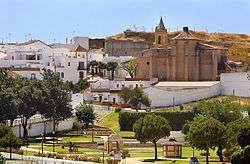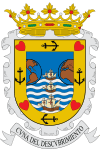Palos de la Frontera
| Palos de la Frontera, Spain | |||
|---|---|---|---|
|
Panoramic view of downtown Palos de la Frontera | |||
| |||
.png) Location of Palos de la Frontera | |||
| Province | Huelva | ||
| Government | |||
| • Mayor | Carmelo Romero Hernández | ||
| Area | |||
| • Total | 50 km2 (20 sq mi) | ||
| • Land | 50 km2 (20 sq mi) | ||
| • Water | 0.00 km2 (0.00 sq mi) | ||
| Population (2015) | |||
| • Total | 10,365 | ||
| • Density | 208.28/km2 (539.4/sq mi) | ||
| Demonym(s) | palermos (m.), palermas (f.) | ||
| Time zone | CET (UTC+1) | ||
| • Summer (DST) | CEST (UTC+2) | ||
| Website | http://www.palosfrontera.com/ | ||
Palos de la Frontera (Spanish pronunciation: [ˈpälos de lä fɾõˈte̯ɾä]) is a town and municipality located in the southwestern Spanish province of Huelva, in the autonomous community of Andalusia. It is situated some 13 km (8 mi) from the provincial capital, Huelva. According to the 2015 census, the city had a population of 10,365. It is most famous for being the place from which Columbus set sail in 1492, eventually reaching America.
History
The official date of foundation for Palos is 1322, when the town was granted to Alonso Carro and Carro's wife Berenguela Gómez by Alfonso XI of Castile, although the town may have been occupied during earlier centuries by Paleolithic, Tartessian, Roman, Visigothic, and Muslim inhabitants. Palos' name is derived from the Latin word palus (“lagoon”). It acquired its “surname” as Palos de la Frontera in May 1642.
At the time of its establishment as a town by Alfonso XI, Palos was part of the Almohad kingdom of Niebla, and was a small nucleus whose population subsisted on fishing and took advantage of the area’s geographic protection against pirates and storms.[1]
Álvar Pérez de Guzmán is considered the city’s real founder. He was only fourteen when Juan I of Castile granted him the towns of Palos and Villalba del Alcor in 1379 to make up for the fact that Pérez de Guzmán was forced to give up Huelva and Gibraleón, which had become part of the county of Medinaceli. Álvar Pérez de Guzmán received from Juan I the right to tax the first fifty families who settled at Palos, and he began utilizing the lands around Palos for the cultivation of olive trees and production of olive oil.[2] After the death of Álvar Pérez de Guzmán, his widow, Elvira de Ayala, daughter of the Chancellor of Castile, continued her husband’s work until her death in 1434.
Palos' Golden Age is considered to have occurred in the 15th century (especially between 1470–1479), when it increased its population to 2,500 inhabitants and its economy, based on fishing and seafaring expeditions to Guinea, flourished.[3] Palos took advantage of the War of the Castilian Succession, which became a war between Castile and Portugal, to challenge Portuguese domination of the Atlantic trade. Castilian naval forces always included natives of Palos, who were considered navigational experts:
...because only the men of Palos know the ancient sea of Guinea, and were used to fighting the Portuguese from the outset of the war, and to snatch from them the slaves acquired in exchange for vile goods— Alfonso de Palencia, Crónica de Enrique IV
Nevertheless, the war ended in defeat for the Castilian forces,[4] and Ferdinand and Isabella, in the Treaty of Alcáçovas (1479) gave up all rights to Atlantic and African lands and seas, with the exception of the Canary Islands, which remained Castilian. Many natives of Palos nevertheless violated the agreement and encroached upon Portuguese sea routes in the Atlantic.[1]
On August 3, 1492, the Pinta, Niña, and Santa María sailed from Palos. On board were Christopher Columbus and the Pinzón Brothers, who were natives of Palos. Palos is also the site of the Rábida Monastery where Columbus consulted with the Franciscans about his plans for organizing an expedition of discovery. The three ships landed in America on October 12, 1492. The Santa María foundered in American waters, but the other two ships returned to Palos on March 15, 1493.
Palos would play a pivotal role in the settlement and Christianization of the New World in succeeding centuries.[5] La Rábida would play a central in the Christian evangelization of the Americas. As La Rábida was a Franciscan monastery, that order would play a dominant role in this Christianization, and some of the first missionaries were natives of Palos, including Juan Izquierdo, Juan de Palos, Juan Cerrado, Pedro Salvador, Alonso Vélez de Guevara, Juan Quintero, Thomás de Narváez, and Francisco Camacho.[6][7]
With the establishment of the Casa de Contratación at Seville in 1503, Palos suffered a decline.[8] Natives of Palos emigrated to America or to Seville, and Palos soon had few sailing vessels of its own.[1] By the 18th century, the town had only about 125 inhabitants. However, during the same century, Catalan investors established a viticultural industry centered at Palos, and the population slowly reached its pre-1492 levels.[1] Palos also transformed itself into a center of the shrimp industries, and also became a center for the cultivation of the “fresón de Palos” (Palos-grown garden strawberries), which are now exported to the European Union.
On June 22, 1926, the first hydroplane to cross the Atlantic, the Plus Ultra flying boat, took off from Palos. The journey, done in six stages, ended at Buenos Aires, Argentina.[9] Alfonso XIII of Spain gave the Plus Ultra to the Argentine Navy, in which it served as a postal service airplane; the Argentines donated to Spain a statue of Icarus, which is situated at La Rábida.[10] Alfonso XIII also granted to Palos the status as a city during this time.[10][11]
John Paul II visited Palos on June 14, 1993, the only time a pope has visited the city. John Paul symbolically crowned the Palos’ patron saint, the Virgin of Miracles (Virgen de los Milagros).
There is a station in the Madrid Metro named after this town.
In 1850 the small town of Trenton, Illinois, located southwest of Chicago, changed its name to Palos. This recommendation was made by M.S. Powell, the local postmaster, whose ancestor Pedro Alonso Niño sailed with Christopher Columbus from Palos de la Frontera. When it incorporated as a Village in 1914, Palos officially became Palos Park. The neighboring communities of Palos Hills and Palos Heights incorporated at later points. All three municipalities lie within Palos Township.
| Wikimedia Commons has media related to Palos de la Frontera. |
Twin Cities
See also
References
- 1 2 3 4 IZQUIERDO LABRADO, Julio, Breve historia de Palos de la Frontera, archived from the original on 2009-10-27, retrieved 27 de marzo Check date values in:
|access-date=(help) - ↑ Carta plomada de Juan II de Castilla por la que confirma a Elvira de Ayala y sus hijas la merced otorgada por Juan I, y confirmada por Enrique III, a Álvaro Pérez de Guzmán, su esposo, de liberación de todo pecho real a 50 vasallos suyos en la villa de Palos.|Archivo: Sección Nobleza del Archivo Histórico Nacional. Signatura: OSUNA,CP.27,D.5. Portal de Archivos Españoles.
- ↑ IZQUIERDO LABRADO, Julio, Cuaderno de Bitácora, ed., ORÍGENES de la Villa de Palos. I. El Puerto de Palos., retrieved 7 Jan 2008 Missing
|last1=in Editors list (help) - ↑ ↓ Historian Malyn Newitt: “However, in 1478 the Portuguese surprised thirty-five Castilian ships returning from Mina [Battle of Guinea] and seized them and all their gold. Another...Castilian voyage to Mina, that of Eustache de la Fosse, was intercepted ... in 1480. (...) All things considered, it is not surprising that the Portuguese emerged victorious from this first maritime colonial war. They were far better organised than the Castilians, were able to raise money for the preparation and supply of their fleets, and had clear central direction from ... [Prince] John.” In A history of Portuguese overseas expansion, 1400-1668, Routledge, New York, 2005, p.39,40.
- ↑ IZQUIERDO LABRADO, Julio, Religiosidad popular en los lugares colombinos: su proyección evangelizadora hacía América, archived from the original on 2009-10-27, retrieved 29 August 2008
- ↑ ROPERO REGIDOR, Diego (1989), Ayuntamiento de Palos de la Frontera, Huelva, ed., Fray Juan Izquierdo: Obispo de Yucatán (1587 - 1602). Historia y Documentos, DL H-148/89 Missing
|last1=in Editors list (help) - ↑ IZQUIERDO LABRADO, Julio. "Palermos ilustres." Págs. 41-42.
- ↑ ÁLVAREZ DE TOLEDO, Luisa Isabel, Sanlúcar de Barrameda: Fundación Casa Medina-Sidonia, ed., [http://americaversus.iespana.es/ África versus América (2ª ed.)], ISBN 978-84-607-1135-3 Missing
|last1=in Editors list (help); External link in|title=(help) - ↑ E.T.S.I. Aeronáuticos (ed.), El vuelo del Plus Ultra: Palos de la Frontera (Huelva) - Buenos Aires, archived from the original on October 17, 2007, retrieved 29 August 2008 Missing
|last1=in Editors list (help) - 1 2 IZQUIERDO LABRADO, Julio, El vuelo del Plus Ultra, archived from the original on 2009-10-27, retrieved 29 August 2008
- ↑ Web Excmo. Ayuntamiento de Palos de la Frontera. (ed.), www.palosfrontera.com https://web.archive.org/web/20071028232125/http://www.palosfrontera.com/turismodlocal/Historico/Muelle_Calzadilla.htm, archived from the original on October 28, 2007, retrieved consultado el 1 de febrero de 2008 Missing
|last1=in Editors list (help); Check date values in:|access-date=(help); Missing or empty|title=(help) - ↑ http://www.femp.es/files/566-1112-archivo/LISTADO%20DE%20HERMANAMIENTOS%20CON%20LATINOAM%C3%89RICA.pdf
Bibliography:
Articles
- Izquierdo Labrado, Julio- Relaciones de Palos de la frontera con el Algarve a finales del siglo XV, La Rábida, 1993.
Books
- Newitt, Malyn (2005) A history of Portuguese overseas expansion, 1400-1668, New York: Routledge.
Chronicles
- Palencia, Alfonso de – Gesta Hispaniensia ex annalibus suorum diebus colligentis, Década III and IV (the three first Décadas were edited as Cronica del rey Enrique IV by Antonio Paz y Meliá in 1904 and the fourth as Cuarta Década by José Lopes de Toro in 1970).
External links
- Palos de la Frontera - Sistema de Información Multiterritorial de Andalucía
- Ayuntamiento de Palos de la Frontera
- Historiador de Palos de la Frontera: Julio Izquierdo Labrado
Coordinates: 37°14′N 6°54′W / 37.233°N 6.900°W


